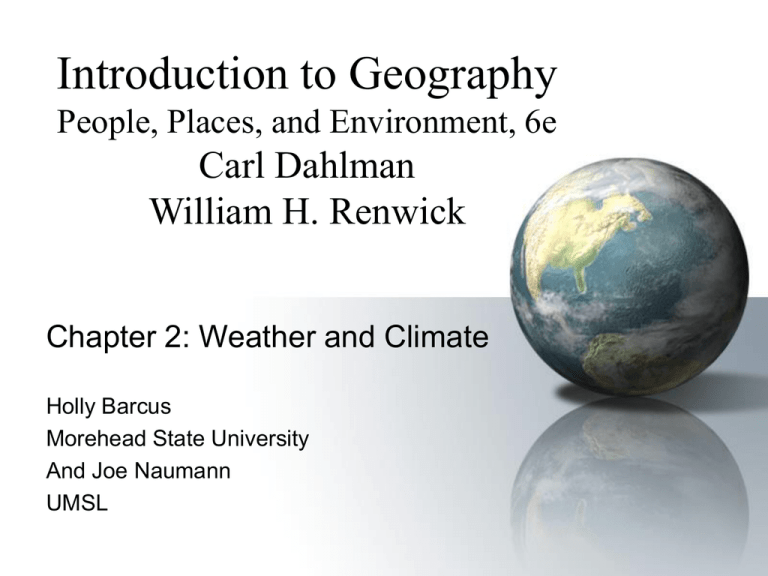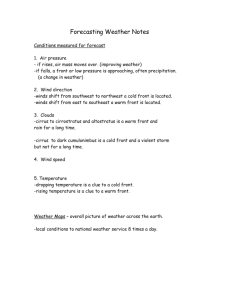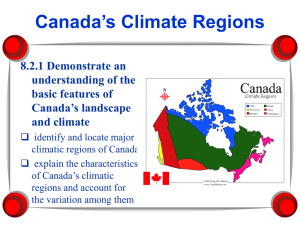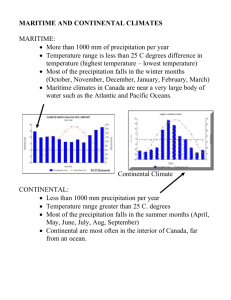Weather and Climate - University of Missouri
advertisement

Introduction to Geography People, Places, and Environment, 6e Carl Dahlman William H. Renwick Chapter 2: Weather and Climate Holly Barcus Morehead State University And Joe Naumann UMSL Weather & Climate affect us in many ways 2 Major Factor in Habitability of Areas • Affects human comfort levels • Affects the “costs” of living and working in an area – extremely high cost of mineral extraction in mineralrich Siberia • Affects the agricultural products that can be produced 3 Weather and Climate • Weather – Day-to-day variations in temperature and precipitation • Climate – Statistical summary of weather conditions through time – Definition: The average yearly pattern of precipitation and temperature. 4 Weather Conditions • Examples: storms, temperature • Movement of “energy” – Fundamental features of Earth’s surface – Regulate natural systems – Limit human use of environment 5 Weather & Climate • Whereas climate is the average annual pattern of precipitation and temperatures for an area, weather is the momentary, and very temporary, condition of the atmosphere. • Weather is experienced moment by moment • To experience the climate of an area, one must live there for many years. To truly experience climate, one must experience the extremes as well as the averages. 6 Solar Energy • Radiant energy from sun (insolation) • Powers circulation of atmosphere and oceans and supports life on Earth • Varies across Earth’s surface 7 Insolation • Amount of energy intercepted by Earth • 2 factors – Intensity of solar radiation – Duration of sunlight 8 Intensity of Solar Radiation • Angle of incidence • Varies daily & seasonally – Axial tilt = 23.5 degrees • Lower angle = larger area = lesser intensity • Higher angle = smaller area = greater intensity 9 Earth-Sun Relationships: Click the Stonehenge picture below to see video • Even in ancient times, humans were able to observe that the relationship differed from day to day in a cycle. 10 Air Temperature • Earth Inclination (23.5º tilt of the axis is responsible for the seasons and redistributing the heat energy received) • Reflection and Reradiation – human actions can affect this • The Lapse Rate – 3.5° per 1000 feet – Decrease with ascent – Increase with descent 11 Latitude • Sun is directly overhead at the equator – March Equinox – March 20 or 21 – September Equinox – Sept. 20 or 21 • June Solstice – June 20 or 21 – Tropic of Cancer • December Solstice – Tropic of Capricorn • Hemispherically Correct Terminology used above 12 Earth Inclination (tilt of axis) • 23½° tilt from the vertical. • Check Tropics of Cancer & Capricorn • Check Arctic & Antarctic Circles • Relationship or coincidence? 13 Length of Day • Total heat received by a place is dependent upon the number of hours of sunlight and its intensity (angle of inclination) • Equator • Higher latitudes 14 Seasonal change in insolation in the middle latitudes • The angle at which the sun’s rays strike the earth change from day to day as a result of the tilt of the earth’s axis, not because the sun moves. North of the Tropic of Cancer and south of the Tropic of Capricorn, the rays never strike at a right angle (perpendicular) 15 What if the axis were perpendicular? 16 Seasonal Variation in Radiation • Varies because of angle of incidence, day length, distance from sun • Equator • High latitudes • Temperature 17 Tilt of the Earth’s Axis -• Responsible for changing lengths of days throughout the year • Responsible for seasons • Responsible for variability of insolation Helps redistribute and moderate temperatures keeping the tropics from being even hotter and the poles colder. 18 Energy Balance 19 Solar Heat Storage • Heat is absorbed by and released from objects • Water absorbs and releases more heat than land – Land heats and cools more quickly and to a greater extent than water – Water is a moderating influence on temperatures 20 Differential Heating of Land and Water 21 Adiabatic Process • Water vapor in the atmosphere affects the heating/cooling rate of air • Latent heat (stored in water vapor) affects temperatures • Latent heat exchange (transfer of heat from lower altitudes to higher ones) is very important in causing precipitation. 22 The Three States of Water 23 Adiabatic Process Video: click the thermometer to see the video • For our purposes, we will only consider the dry lapse rate. • 3.5°F increase per 1000 foot decrease. • 3.5°F decrease per 1000 foot increase 24 Heat Transfer • Responsible for movement of energy from place to place on Earth • Radiation (radiant energy) – Electromagnetic waves • Heat (short waves converted to long waves) – 2 wavelengths: Short (sun - light) and long (Earth heat) 25 Greenhouse Effect • Short vs. long waves • Greenhouse gases – Critical to heat exchange – Water vapor, carbon dioxide, ozone, methane • Increased greenhouse gases = increased global warming 26 Greenhouse Effect • Click the greenhouse to see the video 27 Greenhouse effect & Global Warming • Click the greenhouse to see the video 28 Latent Heat Exchange • Transfers energy from low to high latitudes • Causes precipitation • Two types – Sensible • Detectable by touch – Latent • “In storage” in water and water vapor • Latent heat exchange (adiabatic process) 29 Heat Exchange & Atmospheric Circulation • Convection – Upward movement of fluids caused by heating – “Boiling water” – Atmosphere • Advection – Horizontal movement of air – Monsoons 30 Wind Definition • Wind is the horizontal movement of air from a high pressure area to a low pressure area. 31 Sea Breeze 1. 2. 3. 4. 5. 6. High Pressure Warm air over land rises (low) Sea Breeze moves inland Cumuli develop aloft and move seaward Upper level return land breeze Cool air aloft sinks over water (high) Sea Breeze (meso-cold) Front Low Pressure 32 Land Breeze 1. 2. 3. 4. 5. Low Pressure High Pressure Cool air over land sinks (high) Land Breeze moves out over water Relatively warmer water heats air which then rises (low) Upper level return sea breeze Cool air over land sinks 33 Radiation, Heat & Migrating Tropical Low (ITC) • Notice that the more intense radiation zones move from north of the equator to south of the equator and back – caused by the axis tilt 34 The Tropical Low (ITCZ) – Driving Engine of the Wind System • There is a seasonal lag in the shifting of the wind belts. 35 Apparent shifting of direct radiation from the sun and the resulting wind belts 36 Hydrologic Cycle –Temperature/ Precipitation Relationship Click this diagram to see a video Water vapor is continually changing from a gas to a liquid and from a liquid to a gas. Where it is cold enough, the change also involves ice. 37 Precipitation • “Normal” precipitation • Condensation – Conversion of water from vapor to liquid state • ALL air holds water – Dependent on temperature • Saturation vapor pressure – Maximum water vapor air can hold at a particular temperature 38 Relative Humidity • Water content of air • Percent of water air could hold at a given temperature • Fluctuates hourly as temperature changes Temperature Relative Humidity 86 degrees F 50% if holds half water vapor possible 71 degrees F 75% 60 degrees F 100% • Saturation point = condensation • Condensation = clouds Precipitation: 3 Types • (1) Convectional precipitation – Warm, humid rises, expanding and cooling – Saturation point is reached – Clouds form – Adiabatic cooling • Decrease in temperature that results from expansion of rising air • Convectional storms 40 (2) Orographic Precipitation • • • • Wind forces air up and over mountains Rain on windward side Desert on leeward side: Rain shadow Examples – Cascades & Sierras – Rockies – Exception: Appalachians 42 (3) Frontal Precipitation • Air forced up a boundary between cold and warm air masses • Air mass – Region of air with similar characteristics • Cold front – Cold air mass moves towards warm air mass – Typical weather • Warm front – Warm air mass moves towards cooler air mass – Typical weather 44 Frontal (Cyclonic) Precipitation –curving & rotation come from the Coriolis effect. Normally, a mass of warm air rises above a mass of cooler air when the two masses meet. As the warmer mass cools, there is condensation and possibly precipitation. 47 Cold front closes the gap 48 Circulation Patterns • Air mass = 14.7 lbs per square inch • Atmospheric pressure – Varies with altitude • Higher altitude = less atmospheric pressure – Barometer – Maps use isobars 49 Jet Streams • Fluctuations in the jet streams affect the behavior of various air masses. • Their immediate effect is on weather. 50 Air Masses Affecting N. America Summer WIND BELT SHIFT Winter • St. Louis winter – cyclonic (frontal) precipitation • St. Louis summer – convectional precipitation 51 Pressure and Winds • Air density – Warm air = less dense • Pressure gradient – Difference in pressure between two places • Coriolis Effect – Indirect, curving path of wind caused by rotation of the Earth – Strongest in polar regions 52 Click the picture to see the Flash animation 53 Global Circulation • 4 zones – Intertropical convergence zone (ITCZ) • Convectional precipitation • Trade winds – Subtropical high-pressure zones • Areas of dry, bright sunshine, little precipitation – Midlatitude low-pressure zones • Polar front • Westerlies – Polar high-pressure zones • Dense air, high pressure • Little precipitation • Seasonal variations 54 Wind Belts • In April, the belts start shifting to the north. • In October, the belts start shifting to the south. 55 Monsoon – a seasonal shifting of wind direction. • Wind: horizontal movement of air from a high to a low pressure area • Where? -- South, Southeast, & East Asia 56 • Southeastern U.S. (not as pronounced in the U.S.) Our Water World • Surface – 70% water • Water moves horizontally, vertically, and obliquely • Some movement results in heat transfers – Polar waters to equatorial areas & visa versa – Upwelling of water from depths of 200 ft. plus – Slow descent of surface waters • Some movement doesn’t transfer heat – Storm activity, tidal movements, seismic waves • Ocean currents are those movements that transfer heat 57 Ocean Circulation Patterns • Wind creates waves and currents • Gyres – Wind-driven circular flows • El Niño – Occasional shifts in ocean circulation 58 North Atlantic Drift Moderates European Temperatures Characteristics of Ocean Currents in the three-dimensional oceans • • • • • • • Cold – a relative term Warm – a relative term High salinity – a relative term Weakly saline – a relative term Occurring at great depth Occurring at intermediate depths Occurring at the surface 60 Prevailing Winds Influence Ocean Currents • Between tropics greatest volume of water flows to the west – Influenced by the northeasterly trade wind belt and the southeasterly trade wind belt [solar power?] – Small countercurrent between them – When the westerly currents reach continental shores – are deflected poleward (Coriolis force) • In the midlatitudes, the prevailing westerlies propel the ocean currents to the east • Result: circulating systems (gyres) – Clockwise circulation in northern hemisphere & counterclockwise circulation in southern one. 61 El Nino: Click the CD to see the video • La Nina produces the opposite effects 62 The Ocean’s Role in the Ecosystem • Redistributes heat preventing greater extremes at the tropics and the poles – Poles less cold – Tropics less hot • Source of atmospheric humidity (evaporation) • Home of abundant plant and animal life – valuable food sources • Phytoplankton produce much oxygen 63 Precipitable Water Vapor 64 Storms • Cyclones – Large low-pressure areas – Winds • Counterclockwise in Northern Hemisphere • Clockwise in Southern Hemisphere • Hurricanes and typhoons – Tropical cyclones – Need warm, moist air • Most powerful over oceans – Storm surge • Elevated sea level in center of storm • Midlatitude cyclones 65 Severe Storms: Click the picture of a warm front to see the video 66 Climate • Summary of weather conditions over several decades or more • Influences • Changes over time • Humans and climate • 2 primary measures – Temperature – Precipitation 67 Frequently encountered terms: Tierra Caliente Tierra Templada Tierra Fria Air Temperature • Variation – Latitude – Seasonal solar energy input – Elevation – Topography 68 Precipitation • • • • • • Variable between places and through time Worldwide variation = 0-120 inches Global circulation patterns Amount of precipitation Reliability Regularity – Soil saturation – Human adjustments 69 Classifying Climate • Allows analysis and planning • Communication • Köppen System – Wladimir Köppen, 1918 – Distribution of plants – 5 basic climate types with subdivisions – Most widely used system 70 Climate Regions • Horizontal bands based on latitude • Climate regions similar to – Bioregions/Vegetation Retions – Temperature and precipitation maps • Other influences (see next slide) 71 CLIMATE VARIABLES: Lamppost! • Latitude • • • • • • • Altitude Maritime Influence Pressure Systems Prevailing Winds Ocean Currents Storms Topography 72 Climate System Model 73 Humid Low-Latitude Tropical Climates (A) • Warm all year • Humid tropical (Af, Am) – – – – +/- 10 degrees N/S of equator Warm & humid; Little seasonal temp. variation High temps; Rain Amazon River Basin, Equatorial Africa, Islands of South East Asia • Seasonally humid tropical climates (Aw) – Concentrated rainfall • Seasonal shifts of ITCZ – Central & South America 75 Dry Climates (B) • Dry climates, BW & BS – 35% of Earth’s land area – Border low latitude humid climates on North and South – North Africa, Central Asia • Desert climates (BWh, BWk) – Warm and dry – Subtropics – New Mexico (BWh), China (BWk) • Semi-arid climates (BSh, BSk) – Transitional areas between deserts and humid areas – Grasslands, steppes – Seasonal temperature contrasts 76 Warm Mid-latitude Climates (C) • Seasonal temp variation (4 seasons) – Reversed seasons in the southern hemisphere • Less precipitation • Humid subtropical (Cfa, Cw) – Latitude: 25-40 degrees on east side of continents – Eastern China, SE US, Brazil, Argentina • Marine west coast (Cfb, Cfc) – Continental west coasts, 35-65 degrees – Mild climates – California to coastal Alaska, Southern Chile • Mediterranean climates (Cs) – Dry summers with seasonal precipitation 77 Cold Mid-latitude Climates (D) – Only found in the northern hemisphere • Humid continental climates (Dfa, Dwa, Dfb, Dwb) – Strong contrasts – Remote from oceans = little moisture – Interior & eastern side of Northern Hemisphere Continents (35-60 degrees) • Subarctic climates (Dfc, Dwc, Dfd, Dwd) – – – – Northern edge of humid continental climates No agriculture Northern Hemisphere only Vegetation: Boreal forests 78 None in southern hemisphere • St. Louis on border between Dfa & Cfa to the south 79 Polar Climates (E) • • • • High latitude climates Low temps Extreme seasonal variability Tundra climate (ET) – Permafrost – Tundra • Ice-cap climates (EF) – Near poles & high altitudes at low latitudes 80 USA Climatically “Blessed” • Within the 50 states and Puerto Rico, the USA has some of every type of climate in most classification systems (variations of Kopen – The US can produce at least some of every type of food and industrial crop in the world – No other country has this distinction • The USA has relatively large areas of climate that have the potential to be highly productive agriculturally 81 Climate Change: 3 hypotheses or a combination of them • Astronomical – Geometry of Earth’s orbit – Sunspots • Geologic – Continental drift – Volcanic eruptions • Human (human actions may accelerate or exacerbate changes in the other two) – Atmosphere – pollution & global warming – Vegetation – massive destruction of biomes 82 Climate change is very complex. • Inconstant Climates – historical evidence of significant changes – dynamic, not static • Cyclical Change – cycle of wet and dry years in the Midwest around St. Louis – Have we identified all the various cycles? – More frequent El Niño years? Linked to human actions? • Human Actions – – Global Warming – Great reduction of the rainforests • Major humidity pumps for the atmosphere • Major oxygen producers (often overlooked feature) 83 More about climate cycles • El Niño & La Niña – period between them may be shortening • The “Dust Bowl” was the result of a cycle of wet and dry years in the Great Plains that humans did not understand 84 Human Impact on the Arctic: Click the map to see the video • Global warming • Ozone depletion • Resource extraction • Settlement 85 Solar powered world 86 Solar-Powered World So many things on earth depend on the sun that it may not be an understatement to say that we live on a solar-powered world. 1. Without the sun the earth would be frozen and lifeless 2. Sun warms the earth to a range of temperatures where a variety of chemical compounds exist as solids, liquids, or gases in some places – H2O can exist in all three. 87 More solar-powered world 3. 4. H2O, particularly in liquid state is vital to practically every form of life on earth Sunlight provides the energy for photosynthesis which produces plant food 1. 2. 5. 6. Basis of food chain Uses CO2 and produces O2 Solar energy results in variable heating and cooling of the earth surface, thereby causing wind and driving the wind belts. Ocean currents are partly solar-powered because the wind belts influence them. 88 More solar-powered world 7. Tilt of the earth’s axis helps distribute the insolation over a larger parts of the earth’s surface and causes the seasons. 8. Burning fossil fuels is merely releasing energy that plants received from the sun and locked into their cells long, long ago. 9. Burning wood (hasn’t had time to become a fossil fuel) is also merely releasing energy that plants received from the sun and locked into their cells 89 Solar Powered World: fossil fuels 90 Interactions With Climate Everything is interconnected in the biosphere. • Soil – Decomposer activity – Moisture content • Vegetation – food chain base – Succession of plants & climax vegetation • Available water – Streams & ground water 91 Natural Vegetation • Develops in response to soil and climate • Influences soil by providing the organic matter or humus – i.e. rainforest feed itself • Influences climate – Evapotranspiration provides much of the humidity – the cutting down of tropical rainforests may result in decreased precipitation and prevent the reestablishment of rainforests • Reaches and maintains a climax vegetation condition as long as climate remains constant and human actions don’t interfere. 92 Tropical Rainforest Exists on Extremely Poor Soil Very poor, lateritic soil 93 How “Physical” are the Physical Factors in the Biosphere? • The human impact on climate and other physical systems is a serious problem! The end of Chapter 2 94






